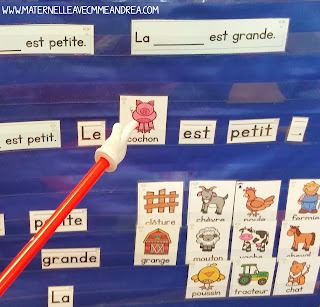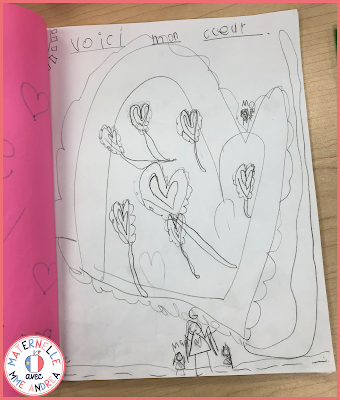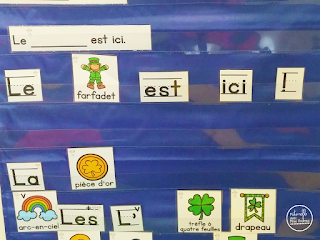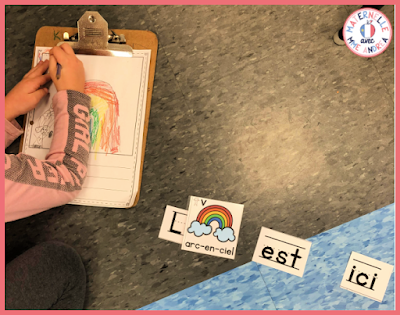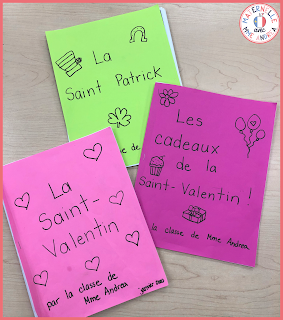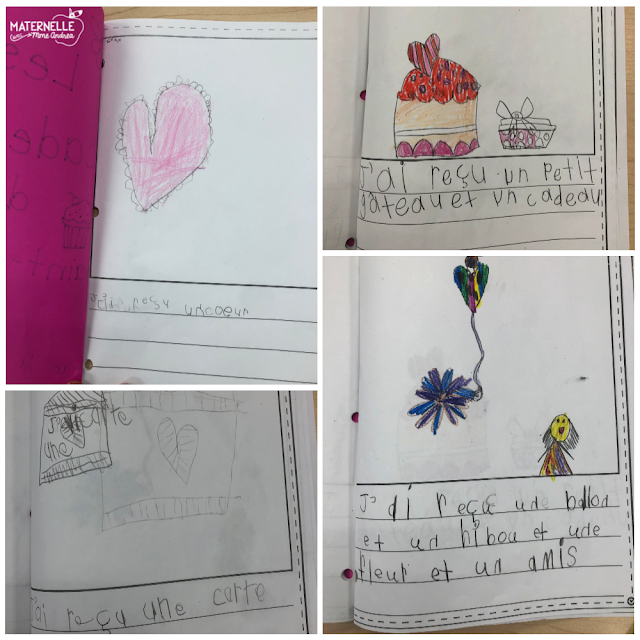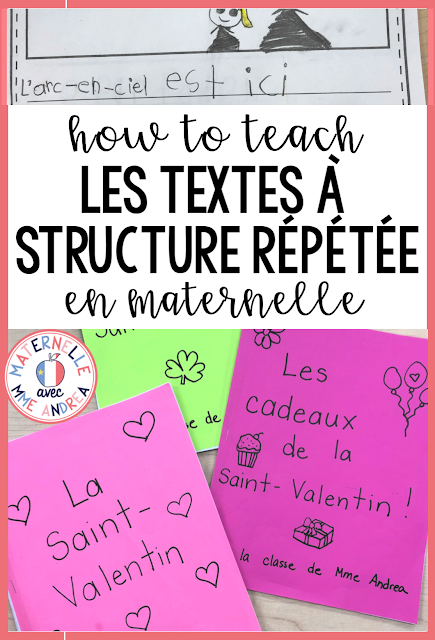If you’ve been following me for awhile, you might have read some of my previous blog posts about writing (like this one or this one).
You’ll know that I don’t really believe in having our maternelle students write from prompts each day, and I advocate modeling teaching them how to write REAL stories, from their brains and hearts, about what they WANT to write about.
Someday, I am going to turn how exactly I do that into a TPT product, with structured lessons for you, but that day is not today haha.
ANYWAY, all that to say that while I generally don’t believe in writing from a prompt and telling my students that they have to write what I say, my school board does require me to teach les textes à structure répétée in maternelle.
And, since it is an expectation, I do teach it, and my students do write them on the regular (by on the regular, I mean we write 1-2 textes à structure répétée per month – the vast majority of what my students write is of their own choosing).
But, since I don’t love it, I have to make it reaaaaallllly easy for me to teach, or else I am much less likely to do it haha.
So, read on to find out how I’ve made les textes à structure répétée super easy and relevant for my students by incorporating them with our Phrases fantastiques!
Side note – in case you’re not sure what textes à structure répétée are, they are the books that our students read around niveaux 1-2, when the sentence structure on each page repeats over and over, but a vocabulary word changes at some point in the sentence. So like « Regarde le papillon. Regarde le chien. Regarde le chat, etc. »
Step 1 – Practice the Basics
Before we even starting talking about
les textes à structure répétée or using what we were learning to co-create a book, I practiced
Les phrases fantastiques with my students over and over.
We started them in December, with the Christmas theme, and only did our first book in February, with the Valentine’s Day theme.
Consistency is the key to mastery, and I wanted to make sure that my students had ample opportunity to practice writing our sentences over and over as a group, focusing on left to right, spaces, punctuation, proper letter formation, etc., before asking them to give them a go on their own.
We practice our sentences 2-3x a week (every other day, usually), and even after getting through our Christmas and Winter themes and moving on to Valentine’s Day, there are still things that we forgot when doing our sentences independently, which you’ll see in some of the pictures below.
So, be sure to practice, practice, practice your sentences as a group before you ask your students to try on their own.
Step 2 – Introduce les textes à structure répétée via a texte à structure répétée
Before talking about making our own book, I also showed my students a few examples of textes à structure répétée via real books.
I am lucky to have a few “big books” for shared reading in my class, but I only have one per level of levels 1-5, so I only actually had one with repeating text. So, after reading that one, I read a couple of our Niveau 1 guided reading books, too.
I asked my students if they noticed anything interesting about the books. How was it so easy for them to jump in and read/recite along with me, even if the books had words in them that they had never seen written down before?
Answer: these books have patterns! The same basic sentence is repeated over and over, with only the last word changing! This type of book is called a texte à structure répétée.
I brought that observation full circle, and pointed out how, even though our pocket chart sentences aren’t books, they are pretty similar – the same basic sentence, but one vocabulary word that changes each time.
I asked my students if they thought that now that we know this, that maybe WE could use our pocket chart sentences to help us make a texte à structure répétée ourselves.
They thought that we should definitely be able to do that ;)
Step 3 – Paper choice
The next step is to choose which kind of paper to use. You can use the included Phrases fantastiques paper, plain paper, lined paper, whatever you like!
For our first book, I decided to use blank paper. I wanted to see how my students would use the space when they had the entire space.
As you might have noticed in the above picture, most of my students added their own lines anyway haha!
So, the next time, I used our regular writing paper – a rectangle on top for the picture, and lines below.
I guess they like what’s familiar!
Step 3 – Model, model, model!
At this point, MANY of my students are able to write the sight words they need for their sentence without copying. We have worked hard on this, and I’m really proud of them!
However, they definitely cannot write the vocabulary words without looking (and nor should they be expected to).
So, to keep us organized and accurate, I have each student choose one of the vocabulary words from our pocket chart. I model this first – I model choosing a word, bringing it to my “spot”, and drawing it.
Then, I model writing my sentence. Do I *just* copy that word?
Nope!
I have to write the whole sentence!
So, we talk about where we can look to find the first sight word we need (in our brains, at the pocket chart, or on the word wall), and copy it over, left to right. I model an uppercase first letter, and the rest lowercase, and I am careful to point that out.
Then, just like when we are writing our sentences together during our regular routine, I model adding a space and continuing the sentence.
I also model checking if there is the symbol for masculin or féminin in the corner of the word and choosing the article to match.
Step 4 – Students Choose Their Word
Most of my sets have enough words that all my students can choose their own word.
If not, I’ll grab more words from the
Mur de mots cards that match that theme and let my students choose from those, too.
They have the same masculin/féminin symbols, so they work just as well!
Most students have different words, but if someone wants to double up and do the same as someone else, I really don’t mind.
Then, everyone finds a spot and gets to work.
Step 5 – Students Write & Illustrate
Each student illustrates their word and then writes their sentence.
I encourage my students to colour their picture, but if they run out of time then they don’t have to.
I don’t like for this activity to take more than one writing period, so if they don’t finish, they don’t finish! No biggie.
(I do have them finish the words before cleaning up – it’s just the colouring that they don’t have to finish)
Many of my students can use what they know to write their sentence, but some need additional support. It’s no problem – I provide them with the words and/or model sentence they need from the pocket chart or word wall.
My students always seem to end up needing different words at different times, and they are great at sharing, so it’s never been a problem!
While my students are working, I circulate and help as needed. I also make the cover page.
This is totally something my students could do and likely will end up doing in the near future – I’ll just ask someone who finishes early to do it for me.
I just use Astrobrights paper and Sharpie marker – nothing fancy!
As my students finish up, I add their pages to the book.
Step 6 – Read!
Once everyone is done or time is up, we go back to the tapis and I read the book.
My students love seeing their work “published”!
By the end of the year, my hope is to have one for everyone to bring home and keep.
In the meantime, I add these books to our reading bins, where my students can read them anytime they want.
They actually choose to read them a lot!
I think they love them not only because they made them, but also because they can read them. We practice our pocket chart sentences so often that they know them inside, out and backward!
As you’ll see in the picture below, my students who are ready to take this activity to the next level do so, by extending their sentences and adding more things.
They did this completely on their own – I didn’t ask them to. They just asked me if they could add more words, and I said sure.
That’s one reason I LOVE writing – it basically differentiates itself!
The following examples are all from the same book:
Love them!
Obviously, I’ve been able to learn from these first attempts – we still need to work lots on punctuation!
So, this past week, we have been focusing BIG TIME on punctuation during reading, writing, our sentences, etc.
I’m hoping that when we do our second Saint Patrick’s Day texte à structure répétée next week, with our new Saint Patrick’s Day sentence, I will see more punctuation popping up.
Why not give it a try?
If you teach
textes à structure répétée and/or use
Les phrases fantastiques in your classroom, why not give these books a try?
While I generally prefer to have my students to write about whatever they want, these texts are great for my students to be able to read & enjoy each others’ work, work together to make a book, and free up their brains to focus on writing mechanics versus content and ideas.
All writing is great, and overall I believe in exposing our students to a variety of types of texts and showing them how to create as many as possible!
If you go this route, just make sure they are getting lots of creative writing time in, too ;)
Looking for more writing tips? Fill out your name & email in the box below, and I’ll email you my FREE guide to writer’s workshop for French primary teachers!



